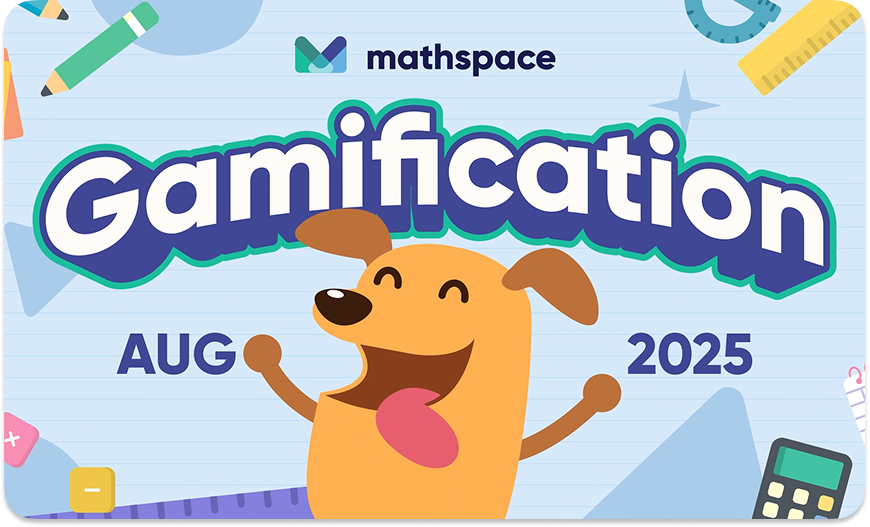Turning practice into progress: How Mathspace gamification supports better outcomes
We’ve launched new gamification features to help students stay motivated and build strong learning habits—backed by research and built for your classroom.

We know motivation plays a crucial role in helping students build long-term learning habits. When students feel confident and engaged, they’re more likely to practise consistently, persist through challenges, and take ownership of their learning.
That’s why we’re excited to launch a suite of new gamification features—designed not just to make learning more fun, but to make it more purposeful.
Gamification with intent
At Mathspace, gamification isn’t about bells and whistles. It’s a strategy to support learning by:
- Rewarding effort over outcomes
- Making progress visible and motivating
- Supporting consistent, spaced practice
We’ve worked closely with educators and learning scientists to design features that align with what matters in the classroom. The result is a set of tools that energise lessons, encourage daily practice, and build confidence—without ever distracting from core learning goals.
The features: how they work and why they matter
Whether you’re looking to energise a review session or support students working independently, there’s a feature to suit your classroom.
For class-wide collaboration and energy
Tug of War
A live, team-based competition where students race to solve questions and pull the flag to their side. Great for bringing energy and peer motivation to revision tasks.
Class Expedition
A monthly class challenge where every student contributes to a shared points goal, unlocking custom rewards when the class reaches their destination. Perfect for building teamwork and consistency over time.
Leaderboard
A weekly ranking based on points earned, designed to celebrate effort and refresh regularly. Students see only their relative position—fostering healthy competition without pressure.
For building independent motivation
Question Streaks
Students earn more points the longer they stay on a roll. This feature supports focus, momentum and productive learning habits.
Personal Best
Each student’s dashboard includes a tracker to help them beat their own weekly high score, reinforcing growth and self-driven progress.
Daily and Weekly Challenges
Low-barrier tasks that encourage consistent practice. Completing multiple daily challenges unlocks extra weekly rewards—turning habit-building into a routine.
For rewarding effort and making progress feel good
Spin the Wheel
A light, daily login bonus where students can win random coin rewards. It adds fun and encourages regular engagement.
Shop & Personalisation
Students can spend earned coins on avatars, accessories, and dashboard backgrounds—bringing personality to their workspace and reinforcing that effort pays off.
Stickers and Outcome Ribbons
Teachers can send stickers for effort, and students receive ribbons for concept mastery—helping to make learning recognition both visible and meaningful.
Built for teachers, backed by research
Every feature is designed to work within your existing lesson flow. You can turn features on or off as needed, and use them alongside your existing planning—no extra prep required.
By pairing scaffolded instruction with retrieval-based practice and gamified challenges, teachers can help students consolidate learning and build momentum over time.
Teaching strategies that make gamification stick
We know that no tool is effective without thoughtful teaching behind it. That’s why we’ve designed our gamification features to work as part of a broader instructional strategy—not to replace one.
In our recent webinar on spaced practice, Mathspace’s Alex Bunt shared a practical model for using gamification to boost retention and build momentum across a topic. The key idea? Use gamification as the final layer in a three-tiered approach to instruction:
- Supportive first exposure: Start with scaffolded instruction—hints, videos and guided help to build confidence.
- Retrieval-based practice: Follow up with low-support tasks to encourage recall and fluency.
- Gamified final challenge: Reinforce learning with a motivating activity like Tug of War, Class Expedition or Daily Challenges.
This approach turns revision into something students look forward to, while also supporting spaced repetition—a strategy proven to improve long-term retention by over 200%.
Teachers using this model have seen strong early results. In one example, a school set aside time each week to revisit the previous week’s content using Tug of War. The result? Higher participation, better recall, and students asking for more review sessions—not fewer.
We’ve also created a new teacher guide to help you get the most out of Mathspace’s gamification features in your classroom. Whether you’re just getting started or looking to deepen your practice, the guide includes:
- A quick-start overview—no extra planning needed
- Tips for choosing features that match your goals
- Sample lesson flows for different year levels
- Planning templates and reflection prompts
- Advice for supporting mixed-ability classes
This guide is designed to help you build routines that stick—without adding to your workload. You’ll find ideas for using features like Tug of War, Streaks and Personal Best in ways that boost motivation and support long-term retention.
By combining thoughtful planning with gamification, teachers can create a rhythm of practice that supports all learners—without adding extra workload.
Watch the webinar here:
Spaced Practice Webinar

